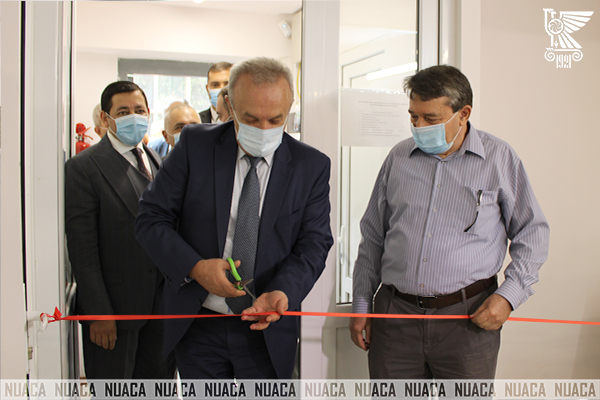


The solemn opening of the Road Construction Testing Laboratory took place today at the National University of Architecture and Construction of Armenia (NUACA) within the framework of the World Bank “SHINLAB” grant program. The RA ESCS Minister Vahram Dumanyan and Deputy Minister Karen Trchօunian were present at the event.
The aim of the program is the improvement of the teaching and study of the “Roads, Bridges and Tunnels” academic program, the development and commercialization of research activities (strengthening the education-science-business relation), as well as the expansion of the University’s educational and scientific functions and capacity building.
Congratulating those present on the opening of the new laboratory, the ESCS Minister Vahram Dumanyan said that this is a vivid example of how laboratories are set up in universities today, which, in addition to ensuring the quality of education, can also solve practical problems for the economy.
“This approach has a great future and we will make every effort to encourage the creation of such opportunities- full-fledged laboratories in all universities,” said the Minister.
According to him, today high-quality roads are already noticeable in the whole territory of the Republic and the existence of the new laboratory will give an opportunity to the construction companies to order various research and to get a scientific result: “In order to have a high-quality road, a quality research must be carried out. In general, construction is a very responsible field; the safety of all of us depends on the quality of construction materials”.
Minister Vahram Dumanyan also noted that the budget discussions are currently underway, the spheres of education and science are among the priorities, and the means to be allocated from the state budget will increase year by year. Regarding the science grant programs, the results of the pilot projects are satisfactory, they will also be continuous.
The Road Construction Testing Laboratory is fully equipped with the latest digital equipment; a classroom equipped with a computer and a projector has been opened next to it so the students will spend the theoretical classes in the classroom and the practical ones in the laboratory.
The equipment of the Road Construction Testing Laboratory makes it possible to test road construction materials for educational purposes: asphalt concrete, bitumen, gravel, as well as to determine the density of the soil, the bends of individual elements of bridges or other structures under external load.
The Rector of NUACA Yeghiazar Vardanyan, congratulating those present, thanked the Ministry and the “Center for Education Programs” PIU for their support: “This laboratory became a reality
as a result of bilateral cooperation, the aim of which is not only to improve the educational process, but also to promote the implementation of scientific programs for the benefit of economic development.”
It should also be mentioned that the “SHINLAB” program was implemented within the framework of the “Quality Education is the Guarantee for High Quality Construction” strategy adopted by the National University of Architecture and Construction of Armenia. Within the framework of the grant program, digitalization of professional courses included in the “Roads, Bridges and Tunnels” academic program – using the Moodle electronic platform, including methodological training of the relevant academic staff is envisaged.
It should also be noted that before the opening ceremony, Minister Vahram Dumanyan and Deputy Minister Karen Trchounian, accompanied by representatives of the University, looked round the educational-scientific laboratories of Construction Materials and Products, Protection and Efficient Use of Water Resources and the Environment, Soil Mechanics, got acquainted with the capacities and the newly acquired equipment. At the end of the visit, the problem of improving the building conditions of the University was also touched upon.